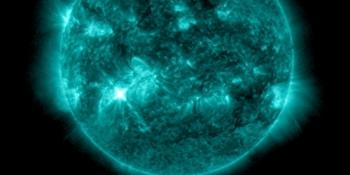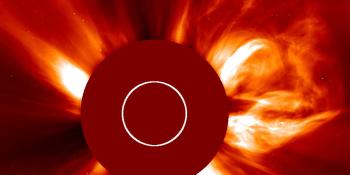Przeglądasz Archiwum z sobota, 28 kwietnia 2001
Raport aktywności słonecznej
Każdy wspomniany rozbłysk słoneczny w tym raporcie ma współczynnik skalowania dodany przez Space Weather Prediction Center (SWPC). Przez skale współczynników SWPC, raporty o rozbłyskach słonecznych są o 42% mniejsze niż naukowo jakościowa data. Skale współczynników zostały usunięte z naszych archiwów o rozbłyskach słonecznych by odzwierciedlić prawdziwe jednostki fizyczne.
Raport aktywności słoneczno- geomagnetycznej 2001 Apr 28 2200 UTCPrzygotowane przez NOAA © SWPC i przetworzone przez SpaceWeatherLive.com
Połączenie raportów USAF/NOAA o słonecznej i geofizycznej aktywności
Numer SDF 118 wydany w 2200Z na 28 Apr 2001IA. Analiza aktywności regionów słonecznych i aktywność od 27-2100Z do 28-2100Z Solar activity dropped to low levels. Region 9433
(N17W50) produced isolated C-class flares, the largest of which was
a C7/1f at 28/0934 UTC. Gradual decay continued in the leading and
intermediate portions of this region. However, no decay was evident
within its trailing spots, where a strong magnetic delta
configuration remained. Region 9441 (N07E23) continued a gradual
growth phase that began on 27 April, but the region remained a
moderate-sized, simply-structured bipole. New Regions 9444 (S11E67)
and 9445 (N23E76) were assigned.
IB. Prognoza aktywności słonecznej
Solar activity is expected to be at
moderate to high levels. Region 9433 is expected to produce isolated
M-class flares. This region could also produce an isolated major
flare during the period.
IIA. Podsumowanie aktywności geofizycznej 27-2100Z do 28-2100Z
Geomagnetic field activity ranged from quiet to minor storm levels.
An interplanetary shock at the leading edge of a CME passed the ACE
spacecraft at 28/0432 UTC, followed by a sudden impulse (SI) at
28/0520 UTC (76 nT, as measured by the Boulder USGS magnetometer).
The source for the CME was an M7/2b flare on 26 April. Field
activity increased to unsettled to minor storm levels following the
SI. The greater than 10 MeV proton flux at geosynchronous orbit
briefly crossed event threshold in response to the shock passage.
The greater than 10 MeV event began at 28/0430 UTC, reached a
maximum of 57 PFU at 28/0500 UTC, then ended at 28/0520 UTC. Proton
fluxes had decreased to near background levels by the close of the
period.
IIB. Prognoza aktywności geofizycznej
Geomagnetic field activity is
expected to be at unsettled to active levels through midday, 29
April as the disturbance gradually subsides. Quiet to unsettled
levels are expected for the remainder of the period. Region 9433
could produce another proton flare before it crosses the west limb
on 02 May. The greater than 2 MeV electron flux at geosynchronous
orbit may reach high levels during the first half of the period.
III. Prawdopodobieństwa zdarzenia 29 Apr do 01 May
| Klasa M | 75% | 75% | 75% |
| Klasa X | 20% | 20% | 20% |
| Proton | 20% | 20% | 20% |
| PCAF | yellow | ||
IV. Przepływ 10,7 cm z Penticton
Zaobserwowano 28 Apr 188 Przewidywane 29 Apr-01 May 185/180/175 Średnia z 90 dni 28 Apr 167
V. Indeks geomagnetyczny A
Zaobserwowano Afr/Ap 27 Apr 003/006 Szacowane Afr/Ap 28 Apr 026/028 Przewidywane Afr/Ap 29 Apr-01 May 015/015-012/010-010/010
VI. Prawdopodobieństwa aktywności geomagnetycznej 29 Apr do 01 May
| A. Średnie szerokości geograficzne | |||
|---|---|---|---|
| Aktywne | 30% | 25% | 20% |
| Słaba burza | 15% | 10% | 10% |
| Bardzo znacząca burza | 10% | 05% | 01% |
| B. Wysokie szerokości geograficzne | |||
|---|---|---|---|
| Aktywne | 35% | 30% | 25% |
| Słaba burza | 20% | 15% | 10% |
| Bardzo znacząca burza | 15% | 10% | 05% |
Wszystkie czasy w UTC
<< Idź do codziennego przeglądu
Najnowsze wiadomości
Najnowsze wiadomości z forum
Więcej tematówWesprzyj SpaceWeatherLive.com!
Wielu ludzi odwiedza SpaceWeatherLive aby śledzić aktywność słoneczną lub sprawdzić czy jest szansa na zaobserwowanie zorzy polarnej. Niestety, większy ruch na stronie oznacza większe koszty utrzymania serwera. Dlatego, jeśli jesteś zadowolony ze strony SpaceWeatherLive, zachęcamy do wspierania nas finansowo. Dzięki temu będziemy mogli utrzymać naszą stronę.

Fakty na temat pogody kosmicznej
| Ostatnie rozbłyski klasy X | 2024/12/08 | X2.2 |
| Ostatnie rozbłyski klasy M | 2024/12/26 | M3.0 |
| Ostatnia burza geomagnetyczna | 2024/12/17 | Kp5+ (G1) |
| Dni bez plam słonecznych | |
|---|---|
| Ostatni dzień bez skazy | 2022/06/08 |
| Średnia miesięczna liczba plam słonecznych | |
|---|---|
| listopada 2024 | 152.5 -13.9 |
| grudnia 2024 | 115.2 -37.3 |
| Ostatnie 30 dni | 118.5 -39.1 |


